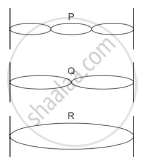Advertisements
Advertisements
प्रश्न
A vibrating tuning fork, held over an air column of a given length with its one end closed, produces a loud audible sound. Name the phenomenon responsible for it and explain the observation.
उत्तर १
The phenomenon responsible for producing a loud audible sound is named resonance. The vibrating tuning fork causes the forced vibrations in the air column. For a certain length of air column, a loud sound is heard. This happens when the frequency of the air column becomes equal to the frequency of the tuning fork.
उत्तर २
Resonance describes the phenomenon. When the tuning fork frequency is 256 Hz, the loudness of a sound can be either 256 Hz or an integer multiple of 256. i.e., (256 × 1) Hz, (256 × 2) Hz, (256 × 3) Hz, ... or (256 × 5). In other words, the frequency of the tuning fork is 256 Hz, 512 Hz, 768 Hz or 1280 Hz.
APPEARS IN
संबंधित प्रश्न
The adjacent diagram shows three different modes of vibrations P, Q and R of the same string.

(i) Which vibration will produce a louder sound and why?
(ii) The sound of which string will have maximum shrillness?
(iii) State the ratio of wavelengths of P and R.
Resonance is a special case of ______ vibrations, when frequency of the driving force is ______ natural frequency of the body.
In following figure shows A, B , C and D represent test tube each of height 20 cm which are filled with water up to heights of 12 cm, 14 cm, 16cm and 18cm respectively. If a vibrating tuning fork is placed over the mouth if test tube D, a loud sound is heard.

- Describe the observations with the tubes A, B and C when the vibrating tuning fork is placed over the mouth of these tubes.
- Give the reason for your observation in each case.
- State the principle illustrated by the above experiment.
Name the phenomenon involved in tuning your radio set to a particular station and define it.
A tuning fork of frequency 256 Hz will resonate with another tuning fork of frequency:
Explain why stringed musical instruments, like the guitar, are provided with a hollow box.
Explain free and forced vibrations. Give an experimental arrangement to illustrate the phenomenon of resonance.
Describe a simple experiment to illustrate the phenomenon of resonance and explain it.
